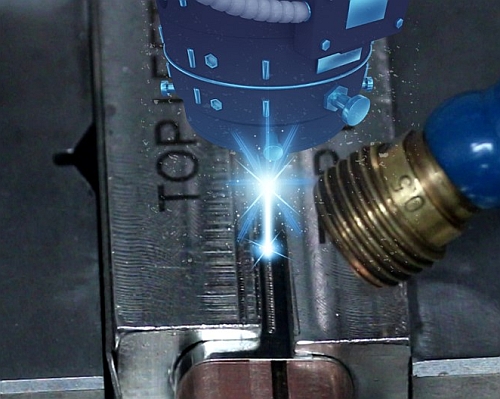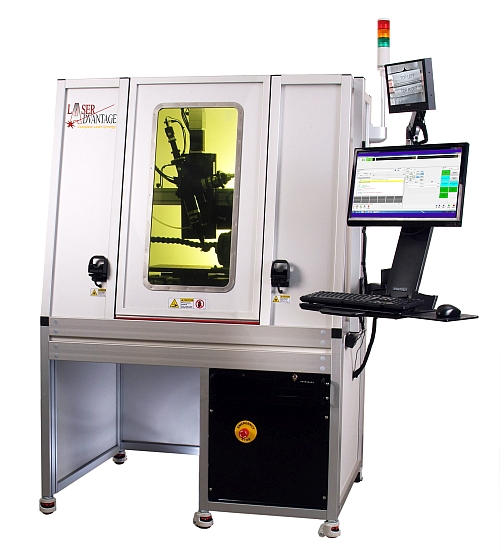Laser Beam Welding
Laser Beam Welding
Laser Advantage provides laser welding utilizing YAG lasers ranging from 10W to greater. All common alloys and pure metals are welded with some requiring special techniques. These include stainless steel, aluminum, titanium, copper, brass, and more. The process can be done in several weld formats but the two most common methods are “spot welding†or “seam welding†and the choice is usually determined by the design of the parts to be welded. Some common welding applications include medical devices, fiber optic equipment, micro-electronic packaging, and aerospace products. Most of our Laser welding systems are 4-axis to accommodate almost any part configuration. All welding is done with a shielding gas to protect the materials from oxidation. Contact us to learn more about how Laser Advantage can help you with your welding needs.
Laser Beam Welding (LBW) or more commonly, laser welding is a high-powered density fusion-welding process used in manufacturing that yields high aspect ratio welds with a relatively low heat input. Laser welding should be considered a principal contender for the production of metallic components for high-performance environments. It is a non-contact process that requires access to the weld zone from one side of the parts–usually comprised of metal, including carbon steels, high strength and low alloy steels, aluminum, titanium and stainless steel.

Micro-Welding at Laser Advantage
Laser beam welding (LBW) is optimal for: a) materials that are difficult to weld using other methods, b) hard to access areas, and c) extremely small components. Typically, a continuous or Quasi-Continuous Wave (QCW) laser beam is used. Millisecond long pulses are used to weld thin materials, such as razor blades; continuous pulsed laser beams are needed for deep welds. Because the laser beam is a single phase light of a single wavelength (monochromatic), it has a low beam divergence with high energy content that creates heat when it strikes a surface.
How Lasers Work
LASER stands for Light Amplification through Stimulated Emission of Radiation. The lasing material or medium can be solid, gas or liquid. The process is the same regardless of the medium.
Stimulated Emission: Energy is absorbed by the laser medium through a high voltage electrical discharge or absorption of photons from a flash lamp or even another laser referred to as optically pumped. The electrons of atoms in the laser medium are excited to a higher energy level where they cannot remain forever. When they fall back to their natural or ground state, the energy is released in the form of photons. Similar to the glow of the dyes in a black light poster when exposed to a UV lamp.
Light Amplification:Â Photons are emitted in all directions. An optical cavity consisting of two mirrors a 100% high reflector and a partial reflector allows some of the light or radiation to escape. Photons bounce back and forth between the mirrors. When a photon passes an atom in an excited state causes that atom to also emit a photon. These two photons then stimulate further photons to be generated in a domino or cascading effect.
Unique Characteristics of Lasers
Coherent: The waves of each photons are all in phase which is to say that the peaks and troughs are aligned.
Monochromatic:Â Lasers are pure in color or consist of a single wavelength. Industrial laser welding systems are almost exclusively infra-red or IR radiation.
Directional: Laser beams have extremely low divergence where they can be projected over incredible distances with little change in the beam diameter. Laser welding and cutting exploit this characteristic by allowing the beam power to be concentrated or focused onto the workpiece. The spot size can be adjusted to vary the weld width and for thick parts, the focal point may be adjusted below the surface to increase the weld depth.
Common Types of Lasers Used in Welding

Carbon Dioxide (CO2) Lasers:Â CO2 lasers were the first to see commercial success for welding and cutting was invented at Bell Labs in 1964 by Kumar Patel. Carbon dioxide gas can be either in a sealed tube or for higher power, a flow through design and is excited by a plasma discharge. The wavelength is quite long, typically 106 µm. As such, special materials are used such as gold coated mirrors and zinc selenide or germanium for windows and lenses. Diamond can be used but is generally cost prohibitive. The CO2 laser is generally continuous wave (CW) with powers between 100 watts and hundreds of kilowatts (kW) for welding. CO2 lasers can also be pulsed through the use of an optical switch (Q-Switch) which allows the gain in the laser to build producing high peak powers, up to gigawatts (GW).
Nd:YAG Lasers: Neodymium-doped yttrium aluminum garnet were the first industrial solid state laser. A crystal is grown and optically pumped by flash lamps or laser diodes. The invention of this laser type is attributed to Bell Labs by J. E. Geusic et al in 1964. The primary or fundamental wavelength is 1.06 um. Because the wavelength is near-IR, lenses and windows can be made of glass or fused silica and mirrors are typically glass or fused silica with a multi-layer dielectric coating designed for optimal reflection at this wavelength. Output power for welding can range from a few hundred to multi-kW.
Diode Lasers: The first semiconductor or diode laser was demonstrated by two groups from General Electric and IBM in 1962. They work in much the same way as LEDs where a current is applied to the P-N junction of a semiconductor material such as Aluminium gallium arsenide (808 nm) or Indium gallium arsenide (980 nm). Individual diodes are arranged in linear bars producing as much as 100W. By then vertically stacking the bars, multi-kW can be produced after the beams have been combined and may be delivered by fiber optics
Fiber Lasers: Industrial fiber lasers have seen explosive growth recently in welding and cutting applications. It was first demonstrated in 1962 by Elias Snitzer, Director of Research at American Optical. The active medium is an optical fiber that has been doped with rare elements; typically, ytterbium, erbium or neodymium with IR wavelengths around 1.06 – 1.7 µm depending on the active material.
How Does Laser Welding Work?

The laser beam welding application applies a concentrated coherent laser beam at the surfaces to be joined. The process produces heat and the heat obtained causes the materials being welded to fuse or come together. Laser beam energy has the highest energy concentration used in science and manufacturing. The electromagnetic energy contained in the laser beam is concentrated and can access small parts with unparalleled accuracy in the welding application. Currently, lasers are seeing ever increasing uses in welding even though capital investment is higher than traditional methods. Improvements are occurring rapidly and those changes will reflect cost reductions. Another advance is the use of fiber optic techniques that successfully carry the laser beam to the point of welding lending it to easy robotic integration and access to confined spaces. This is expected to substantially increase the use of lasers in metal work in all industries.
It is important not to be confused between laser beam energy transfers and arc welding processes. One advantage over arc welding is that laser output is not electrical and does not require a flow of electrical current thus eliminating any effect of magnetism.
LBW is not limited to electrically conductive materials because lasers can interact with any material. The laser beam can be transmitted through air rather than requiring a vacuum and the LBW process is easily automated. X-rays are not generated and LBW yields higher quality welds.
Why is LBW a better option?
The absorption of energy by a specific material in the LBW process is affected by the type of laser, power density and the surface condition of the material. Of note is the fact that once metal is raised to its melting temperature, the surface conditions have little or no effect in the LBW process. Thus, there is no concern that reflectivity is involved in heating the base metal. Since the laser beam has very little deviation, the distance from the optical nook to the base metal has little impact on the effectiveness of the laser. LBW is focused to the proper spot size and uses the same amount of available energy, regardless of distance. The speed of welding is proportional to the amount of power supplied but will also depend on the type and thickness of the focal point. LBW has much higher heating and cooling rates than arc welding and the heat-affected areas are much smaller. With smaller heat zones, cooling areas are of course reduced, which limits problems such as cracking in high carbon steels that may occur with rapid cooling of expanded areas, although cracking may appear in some metals.
Types of Welds
Laser conduction mode welding relies on the conductivity of the material being welded. There are two modes, direct heating and energy transmission. In direct heating, the heat flow is controlled by classic thermal conduction from a surface heat source. The heat is conducted into the base material causing the material to change from a solid to a liquid and the two separate liquids fuse. When the materials change back to solid, the weld is secured at that focal point. Laser conduction welds are primarily used for spot welding, continuous and partial penetration seam welding. Direct heating can be achieved using CO2 lasers, Nd:YAG, Fiber and Direct diode lasers which work well on a wide range of metals as well as alloys.
Keyhole welding is used to create deep, narrow welds. This occurs when the laser light forms a thread of vaporized material, known as a keyhole, which spreads into the material. The hole is sealed by the molten material behind the laser and the result is referred to as a keyhole weld. This process serves as a conduit for the laser light to be successfully conveyed into the material.
Another type of weld is created by laser soldering and brazing, wherein the laser beam melts a filler. The filler in turn wets the edges of the joint without melting the base materials and has been used successfully for decades in joining electronic board leads.
Key Benefits of Laser Beam Welding
- Ultimate precision
- Create complicated joints in areas difficult to reach with other techniques
- Low heat application, minimizes distortion and cracking
- Consistency
- High strength welds
Laser welding is the smart choice for your business. This technology provides strong and reliable results, and amazing levels of versatility and will help your business increase efficiency in manufacturing. Laser Advantage has over 30 years of experience in applying a variety of laser types in some of the most demanding applications. Regardless if you need contract manufacturing, job shop services or turn-key systems, contact us today to discuss your requirements.
Get a Quote
Get in touch with us to discuss your needs.